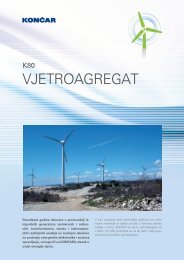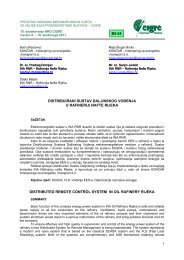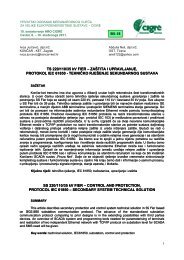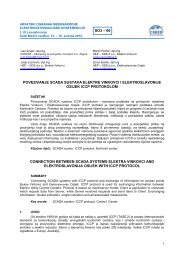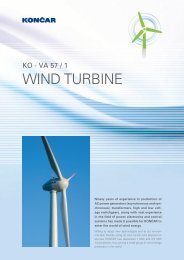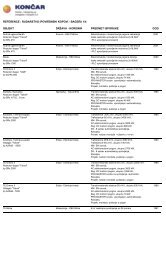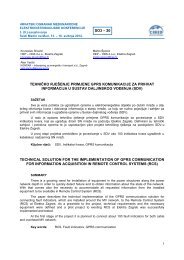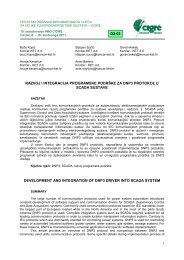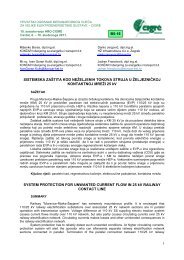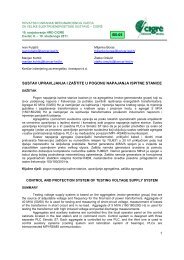Protection relay software models in interaction with power system simulators
Protection relay software models in interaction with power system ...
Protection relay software models in interaction with power system ...
- No tags were found...
Create successful ePaper yourself
Turn your PDF publications into a flip-book with our unique Google optimized e-Paper software.
<strong>Protection</strong> <strong>relay</strong> <strong>software</strong> <strong>models</strong> <strong>in</strong> <strong>in</strong>teraction<br />
<strong>with</strong> <strong>power</strong> <strong>system</strong> <strong>simulators</strong><br />
Ivan Goran Kuliš * , Ante Marušić ** and Goran Leci *<br />
*<br />
Končar-Power Plant and Electric Traction Eng<strong>in</strong>eer<strong>in</strong>g, Zagreb, Croatia<br />
**<br />
Faculty of Electrical Eng<strong>in</strong>eer<strong>in</strong>g and Comput<strong>in</strong>g, Zagreb, Croatia<br />
ivangoran.kulis@koncar-ket.hr<br />
Abstract - Modell<strong>in</strong>g and simulation <strong>software</strong> developed for<br />
analys<strong>in</strong>g protective <strong>relay</strong><strong>in</strong>g applications and <strong>relay</strong> design<br />
concepts <strong>in</strong> <strong>power</strong> distribution is described <strong>in</strong> the paper.<br />
The <strong>in</strong>tention was to develop an open <strong>system</strong> that is easy to<br />
use and allows simple future expansions. Easy to use<br />
presumes that the <strong>software</strong> should be suitable for teach<strong>in</strong>g<br />
purposes. This is achieved by <strong>in</strong>troduc<strong>in</strong>g new libraries of<br />
signal sources and <strong>relay</strong> elements developed <strong>in</strong> the<br />
MATLAB/SIMULINK environment. Comb<strong>in</strong>ed <strong>with</strong> the<br />
SIMULINK/SimPowerSystems, the mentioned libraries<br />
enable a variety of studies aimed at better understand<strong>in</strong>g<br />
protective <strong>relay</strong> design approaches and procedures and<br />
related applications <strong>in</strong> <strong>power</strong> <strong>system</strong>.<br />
I. INTRODUCTION<br />
In the MV networks <strong>in</strong> Croatia there are three ways of<br />
substation (transformer) neutral po<strong>in</strong>t ground<strong>in</strong>g<br />
treatment: isolated, low-ohmic grounded and, from a<br />
couple of years ago, resonant grounded. Croatian MV<br />
distribution networks are ma<strong>in</strong>ly radially operated.<br />
With an aim to def<strong>in</strong>e the criteria for appropriate<br />
neutral treatment selection depend<strong>in</strong>g on the substation<br />
and MV network type, an overview study has been<br />
conducted recently. Selection criteria <strong>in</strong> the study<br />
considered:<br />
Technical features of all three treatments<br />
concern<strong>in</strong>g the earth-fault currents, overvoltages<br />
and network operation based on literature,<br />
measur<strong>in</strong>g, computer analysis and operation<br />
experiences;<br />
Human safety requirements and rules (touch<br />
voltages), heath and voltage stresses and<br />
<strong>in</strong>terferences <strong>with</strong> telecommunications l<strong>in</strong>es;<br />
Network importance (number and type of<br />
connected customers), size (length of galvanic<br />
connected l<strong>in</strong>es), type (cable to overhead l<strong>in</strong>es<br />
ratio, type of poles and types of cable junctions and<br />
screens);<br />
Network reliability (SAIFI and SAIDI);<br />
Earth <strong>system</strong>s requirements concern<strong>in</strong>g earthfault<br />
currents and soil resistivity.<br />
Every criterion has been economically evaluated<br />
regard<strong>in</strong>g capital and operation expenditure and then costbenefit<br />
analyses have been made. The results of those<br />
analyses are criteria for adequate neutral treatment<br />
selection concern<strong>in</strong>g mentioned features, requirements<br />
and rules.<br />
The study also emphasized the need for rules<br />
renovation regard<strong>in</strong>g a new way of operation and<br />
protection <strong>relay</strong> requirements as well as harmonization<br />
<strong>with</strong> European norms. The need for implementation of<br />
new protection methods and primary measur<strong>in</strong>g<br />
equipment (current and voltage transformers) coord<strong>in</strong>ation<br />
have also been considered and analysed. The analysis<br />
performed and the results achieved are described <strong>in</strong> this<br />
article.<br />
In the scope of the study, measurements of pre-fault<br />
and earth-fault currents and voltages were conducted <strong>in</strong><br />
10 kV and 20 kV distribution networks supplied from two<br />
HV/MV substations. Earth-faults were done <strong>with</strong> different<br />
fault resistances and types as well as by us<strong>in</strong>g different<br />
neutral po<strong>in</strong>t ground<strong>in</strong>g methods: isolated, low-ohmic<br />
resistive and resonant.<br />
II.<br />
CHARACTERISTICS OF SELECTIVE EARTH-FAULT<br />
PROTECTION IN DISTRIBUTION NETWORKS<br />
Methods for selective detection of earth faults are<br />
based on measurements either of permanent or transient<br />
currents and voltages upon earth-faults occurrence. A<br />
special property of the isolated and resonant earthed<br />
networks is the rise <strong>in</strong> magnitude of the measured earthfault<br />
current due to the contribution from healthy feeders,<br />
while feeder <strong>with</strong> the failure has no impact on it.<br />
Measurements of available currents and voltages <strong>in</strong> the<br />
event of an earth-fault, unless these values are not post<br />
processed, <strong>in</strong>dicate the use of directional earth-fault<br />
protection. Because of compensation <strong>in</strong> resonant earthed<br />
networks, <strong>with</strong> reference to earth-fault current reduction, it<br />
is obvious that protective equipment, <strong>in</strong>clud<strong>in</strong>g<br />
transformers, must meet very high requirements. Most<br />
methods work under adverse conditions of the phase shift<br />
between current and voltage (~90°). Contrary to the<br />
measur<strong>in</strong>g conditions dur<strong>in</strong>g short-circuits, current<br />
transformers (CT) are often not adapted to deal <strong>with</strong> a<br />
small earth-fault currents. Adjustment is to be achieved by<br />
us<strong>in</strong>g r<strong>in</strong>g-type (toroidal) transformers. These<br />
requirements are even greater <strong>in</strong> meshed than <strong>in</strong> radial<br />
networks because of earth fault currents spread<strong>in</strong>g through<br />
branches.<br />
Most commonly used numerical <strong>relay</strong>s for selective<br />
earth-fault detection are:<br />
Neutral overcurrent <strong>relay</strong> (50/51N)<br />
Directional and sensitive directional neutral<br />
overcurrent <strong>relay</strong> (67N(S))<br />
MIPRO 2012/CTS 1065
Wattmetric and warmetric neutral <strong>relay</strong>s<br />
(32P/QN)<br />
Neutral overcurrent <strong>relay</strong> based on higher (5 th )<br />
harmonic<br />
This <strong>relay</strong> operation is based on the fact that <strong>in</strong> the<br />
resonant networks 5 th harmonic is not<br />
compensated by Petersen coil. 5 th harmonic is<br />
usually <strong>in</strong>tentionally added upon earth-fault<br />
occurrence.<br />
Relay for static or dynamic comparison of neutral<br />
currents<br />
This <strong>relay</strong>s operation is based on comparison of<br />
neutral currents or their changes. Neutral currents<br />
of different feeders connected on the same busbar<br />
are compared.<br />
Admittance and conductance neutral <strong>relay</strong>s<br />
This <strong>relay</strong>s operation is based on comparison of<br />
neutral admittances/conductance’s changes.<br />
Transient <strong>relay</strong>s<br />
This <strong>relay</strong>s tracks and compares voltage and<br />
currants wave shapes at earth-fault occurrence.<br />
III.<br />
RELAY MODELLING<br />
Protective <strong>relay</strong>s together <strong>with</strong> current and voltage<br />
transformers are a substantial part of the <strong>power</strong> <strong>system</strong>.<br />
Protective <strong>relay</strong>s rapidly isolate faulted part of the <strong>system</strong><br />
which allow <strong>system</strong> stability and undisturbed <strong>power</strong><br />
supply for most customers. Incorrect operation of<br />
protective <strong>relay</strong>s can have adverse consequences for<br />
cont<strong>in</strong>ued <strong>power</strong> supply. Develop<strong>in</strong>g, us<strong>in</strong>g and teach<strong>in</strong>g<br />
protective <strong>relay</strong> application and design concepts assumes<br />
multidiscipl<strong>in</strong>ary approach compris<strong>in</strong>g among others<br />
<strong>power</strong> <strong>system</strong> physics, mathematical formulations and<br />
electronic devices. Majority of components that constitute<br />
a modern electrical <strong>power</strong> <strong>system</strong> have been successfully<br />
modelled for transient studies for more than forty years.<br />
The exception is protective <strong>relay</strong><strong>in</strong>g. Progress <strong>in</strong><br />
modell<strong>in</strong>g of <strong>power</strong> <strong>relay</strong>s <strong>in</strong> transient analysis appeared<br />
<strong>in</strong> the last twenty years.<br />
Electrical faults, switch<strong>in</strong>g actions and other <strong>power</strong><br />
<strong>system</strong> disturbances, cause a redistribution of the electric<br />
and magnetic energy stored <strong>in</strong> capacitive and <strong>in</strong>ductive<br />
elements and mechanic energy stored <strong>in</strong> rotational<br />
elements of the network. This redistribution of electric<br />
energy cannot occur <strong>in</strong>stantaneously and the <strong>power</strong> <strong>system</strong><br />
must undergo through a transient state before it reaches a<br />
new steady state. Dur<strong>in</strong>g the first few cycles follow<strong>in</strong>g a<br />
<strong>power</strong> <strong>system</strong> fault, high-speed protective <strong>relay</strong>s are<br />
expected to make a correct decision as to the presence and<br />
location of the fault <strong>in</strong> order to preserve <strong>system</strong> stability<br />
and to m<strong>in</strong>imize the extent of equipment damage. The<br />
majority of protective <strong>relay</strong>s make their decisions based<br />
on fundamental frequency (50 Hz or 60 Hz) voltage and<br />
current signals. However, it is precisely at this moment<br />
that the voltage and current signals are badly corrupted by<br />
fault-<strong>in</strong>duced transients <strong>in</strong> the form of an exponentially<br />
decay<strong>in</strong>g dc component, and <strong>with</strong> frequencies above and<br />
below the fundamental <strong>power</strong> <strong>system</strong> frequency. The<br />
dynamic performance of protective <strong>relay</strong>s depends to a<br />
large extent on their design pr<strong>in</strong>ciple that addresses th<strong>in</strong>gs<br />
such as selectivity, sensitivity, security, and dependability.<br />
In addition, the dynamic performance of high-speed<br />
protective <strong>relay</strong>s depends to a large extent on the signals<br />
produced by <strong>in</strong>strument transformers, and these signals<br />
depend on the overall transient response of the <strong>in</strong>strument<br />
transformers, and the type of transients generated by the<br />
<strong>power</strong> <strong>system</strong> [1, 2, 3].<br />
Relay <strong>software</strong> <strong>models</strong> are useful for <strong>relay</strong><br />
manufacturers, utilities, customers and also for<br />
educational purposes. In general, manufacturers use more<br />
sophisticated <strong>models</strong> to support development and<br />
presentation. Representatives of manufacturers can<br />
expla<strong>in</strong> the behaviour of the <strong>relay</strong>s to their clients <strong>with</strong> the<br />
help of <strong>relay</strong> <strong>models</strong> us<strong>in</strong>g <strong>in</strong>put from network simulation<br />
programs or from <strong>power</strong> <strong>system</strong> transient recorders.<br />
Depend<strong>in</strong>g on the purpose they serve it is possible to<br />
create more or less sophisticated <strong>relay</strong> <strong>models</strong>. Simple<br />
<strong>models</strong> use only mathematical equations to describe the<br />
pick-up and tripp<strong>in</strong>g characteristics of the <strong>relay</strong>s. These<br />
<strong>models</strong> can be used to make general decisions for the<br />
selection of <strong>relay</strong> types, and together <strong>with</strong> network<br />
calculation programs they can be used to derive <strong>relay</strong><br />
sett<strong>in</strong>gs.<br />
More sophisticated <strong>relay</strong> <strong>models</strong> are much more<br />
comprehensive. They process voltage and current transient<br />
waveforms from emtp simulations, actual fault waveforms<br />
captured by numerical <strong>relay</strong>s, or digital fault recorders.<br />
This way user can observe their response to these<br />
transients and reaffirm the protection behaviour dur<strong>in</strong>g<br />
network disturbances.<br />
IV.<br />
RELAY MODELLING IN MATLAB<br />
Matlab has been selected as programm<strong>in</strong>g<br />
environment for protective <strong>relay</strong><strong>in</strong>g <strong>software</strong> modell<strong>in</strong>g<br />
for the follow<strong>in</strong>g reasons:<br />
Matlab is well recognized as one of standard tools<br />
for protective <strong>relay</strong> modell<strong>in</strong>g <strong>in</strong> <strong>in</strong>dustry and <strong>in</strong><br />
university environment [1, 2, 4].<br />
Matlab has <strong>power</strong>ful calculation and visualisation<br />
tools and enables fast and efficient <strong>software</strong><br />
expansion <strong>with</strong>out develop<strong>in</strong>g any extra<br />
programm<strong>in</strong>g tools.<br />
Matlab and its time doma<strong>in</strong> solver Simul<strong>in</strong>k create<br />
an open and user friendly <strong>system</strong>. They provide<br />
libraries, <strong>models</strong> and programs enabl<strong>in</strong>g<br />
<strong>in</strong>tegration of different model components. New<br />
<strong>models</strong> and libraries can be easily added.<br />
Simul<strong>in</strong>k and SimPowerSystems allow fast<br />
development and closed-loop test<strong>in</strong>g of protection<br />
and control <strong>system</strong>s used <strong>in</strong> <strong>power</strong> <strong>system</strong>s and<br />
drives. This is important s<strong>in</strong>ce actual <strong>power</strong><br />
<strong>system</strong>s and their protection <strong>system</strong>s operate <strong>in</strong> a<br />
closed-loop manner [2, 5]. SimPowerSystems<br />
enable modell<strong>in</strong>g of <strong>power</strong> <strong>system</strong> components. It<br />
provides computations and analyses similar to<br />
other electromagnetic transient programs<br />
permitt<strong>in</strong>g modell<strong>in</strong>g of the <strong>power</strong> <strong>system</strong>s and its<br />
controls <strong>in</strong> the same environment and thus,<br />
facilitat<strong>in</strong>g closed-loop simulation.<br />
The (earth-fault) <strong>relay</strong>s are modelled so that the<br />
general work<strong>in</strong>g pr<strong>in</strong>ciples of protection <strong>system</strong>s can be<br />
demonstrated. The <strong>in</strong>teraction between network<br />
1066 MIPRO 2012/MEET
calculation program and <strong>software</strong> protection <strong>system</strong><br />
<strong>models</strong> is achieved. Closed-loop simulations of <strong>relay</strong><br />
<strong>software</strong> <strong>models</strong> <strong>with</strong> an electromagnetic transient<br />
simulation enables evaluation of the transient behaviour of<br />
the protective <strong>relay</strong><strong>in</strong>g algorithms due to changes and<br />
switch<strong>in</strong>g <strong>in</strong> the network. Different protection sett<strong>in</strong>gs and<br />
their consequences on the protection behaviour are<br />
possible as well as protection coord<strong>in</strong>ation analysis. In this<br />
manner the application of <strong>relay</strong> <strong>models</strong> can effectively<br />
support the education of students and eng<strong>in</strong>eers.<br />
Intention is to develop <strong>relay</strong> <strong>software</strong> modell<strong>in</strong>g for<br />
relevant test<strong>in</strong>g prior the build<strong>in</strong>g of a prototype <strong>relay</strong>s.<br />
This is essential <strong>in</strong> the development process because, it<br />
allows test<strong>in</strong>g of various <strong>relay</strong><strong>in</strong>g algorithms, the <strong>relay</strong><br />
logic, and to make necessary changes <strong>with</strong>out the need to<br />
make changes <strong>in</strong> hardware or <strong>software</strong> modules of the<br />
actual device. Relay algorithm development enables use<br />
of <strong>relay</strong> <strong>software</strong> <strong>models</strong> to test different digital signal<br />
process<strong>in</strong>g techniques, protection algorithms, the transient<br />
response of digital filters, phasor estimat<strong>in</strong>g methods,<br />
directional or distance element unit performance and<br />
evaluation of new measur<strong>in</strong>g techniques.<br />
Of course, all previously mentioned cannot completely<br />
replace tests <strong>with</strong> the actual protection devices <strong>in</strong> a real<br />
environment. Whatever degree of detail is used <strong>in</strong> a<br />
model, the eng<strong>in</strong>eer must be aware of the limitations of<br />
the model. Failure to bear this <strong>in</strong> m<strong>in</strong>d is a well-known<br />
weakness <strong>in</strong> all design studies based on <strong>models</strong> [3].<br />
V. DISTRIBUTION POWER SYSTEM MODEL<br />
With<strong>in</strong> Matalabs Simul<strong>in</strong>k environment,<br />
SimPowerSystems are selected as a design tool for<br />
modell<strong>in</strong>g and simulat<strong>in</strong>g a distribution <strong>power</strong> <strong>system</strong>. In<br />
Simul<strong>in</strong>k environment it is possible to model and simulate<br />
the total <strong>system</strong> by comb<strong>in</strong><strong>in</strong>g SimPowerSystem <strong>with</strong><br />
control <strong>system</strong> tools. This allows optimisation of control<br />
parts of the model. Accurate and fast real-time simulations<br />
are possible by us<strong>in</strong>g variable step <strong>in</strong>tegrator and zero<br />
cross<strong>in</strong>g detection capabilities.<br />
The <strong>system</strong> is modelled accord<strong>in</strong>g to the two real<br />
radial distribution networks <strong>in</strong> which earth-fault tests were<br />
done. Current and voltage measured records from tests are<br />
used for model calibration and also as a signal source for<br />
test<strong>in</strong>g the <strong>relay</strong> <strong>models</strong>.<br />
Earth-fault and resonant curve field tests have been<br />
conducted <strong>in</strong> the substations 110/20 kV Bot<strong>in</strong>ec and<br />
110/10 kV Velika Gorica. Tests consisted of earth-faults<br />
over different fixed resistances (1÷5 Ω, 1, 4 and 10 kΩ)<br />
and <strong>in</strong> different conditions (phase wire fell on dry and wet<br />
ground, phase wire fell on trees, transient faults simulated<br />
<strong>with</strong> variable spark gap) at few places <strong>in</strong> the networks<br />
<strong>with</strong> ungrounded, low-ohmic grounded and resonant<br />
grounded neutral po<strong>in</strong>ts. Earth-faults <strong>with</strong> resonant<br />
grounded neutral po<strong>in</strong>ts have been done <strong>with</strong> different<br />
tun<strong>in</strong>g of Petersen coils <strong>with</strong> and <strong>with</strong>out shunt resistor<br />
(connected on secondary w<strong>in</strong>d<strong>in</strong>g). Resonant curves were<br />
also measured and recorded.<br />
MV networks supplied from these substations are<br />
mostly wide spread semi urban radially operated, <strong>with</strong><br />
only a few meshed branches. This k<strong>in</strong>d of network was<br />
considered as most <strong>in</strong>terest<strong>in</strong>g for resonant ground<strong>in</strong>g<br />
method implementation. It is because these networks have<br />
8 to 12 feeders on one bus-bar <strong>system</strong>, <strong>with</strong> total sum of<br />
100 to 300 A capacitive currents, large numbers of short<br />
and long supply <strong>in</strong>terruptions and a lot of households and<br />
small <strong>in</strong>dustries connected and <strong>with</strong> ~21 MVA of average<br />
peak load.<br />
Modelled distribution network <strong>with</strong> wattmetric <strong>relay</strong><br />
(red box) on feeder 1 is shown <strong>in</strong> Figure 1. Earth-fault is<br />
simulated on phase A of feeder 1.<br />
Figure 1: Radial distribution network modelled <strong>in</strong> Matlab<br />
VI.<br />
RELAY MODELS<br />
Erath-fault <strong>relay</strong>s are modelled as generic numerical<br />
<strong>relay</strong>s. In Matlab/Simul<strong>in</strong>k environment, <strong>relay</strong>s are<br />
modelled <strong>in</strong> the function blocks as it is shown <strong>in</strong> Figure 2.<br />
Power <strong>system</strong> model<br />
Relay model<br />
Simul<strong>in</strong>k/SymPowerSystem<br />
EMT Power <strong>system</strong> simulation<br />
CT & VT<br />
transducers<br />
Auxiliary CT & VT<br />
transducers<br />
Signal condition<strong>in</strong>g<br />
Sampl<strong>in</strong>g & A/D<br />
conversion<br />
Phasors comput<strong>in</strong>g<br />
Relay algorithm<br />
Figure 2: Power <strong>system</strong> and <strong>relay</strong> device model presented <strong>in</strong> the<br />
function blocks<br />
Trip<br />
MIPRO 2012/CTS 1067
Power <strong>system</strong> model<br />
Power <strong>system</strong> is modelled <strong>in</strong> Simul<strong>in</strong>k environment by<br />
use of SimPowerSystem and other Simul<strong>in</strong>k library<br />
elements.<br />
SimPowerSystem is a design tool for modell<strong>in</strong>g and<br />
simulat<strong>in</strong>g electrical <strong>power</strong> <strong>system</strong>s <strong>with</strong><strong>in</strong> the Simul<strong>in</strong>k,<br />
allow<strong>in</strong>g a <strong>power</strong> <strong>system</strong> model to be built <strong>in</strong> an easy<br />
manner. It is a <strong>power</strong>ful solution for modell<strong>in</strong>g the<br />
electrical <strong>power</strong> <strong>system</strong>, especially when design<strong>in</strong>g<br />
associated control and protection <strong>system</strong>s. The library<br />
conta<strong>in</strong>s blocks that represent common components and<br />
devices found <strong>in</strong> electrical <strong>power</strong> networks. The blocks<br />
are based on well-known electro-magnetic and electromechanical<br />
equations. The libraries conta<strong>in</strong> <strong>models</strong> of<br />
typical <strong>power</strong> equipment.<br />
Distribution <strong>system</strong> is mostly modelled by common<br />
library elements <strong>with</strong> m<strong>in</strong>or modifications where<br />
necessary, as for example <strong>with</strong> arc model. Even though to<br />
Matlab is <strong>in</strong>herent slower <strong>power</strong> <strong>system</strong> simulation<br />
(compared <strong>with</strong> EMTP (ATP) [1]), this drawback is<br />
negligible s<strong>in</strong>ce the distribution model does not present<br />
large <strong>system</strong>.<br />
Measur<strong>in</strong>g (<strong>in</strong>strument) transformer <strong>models</strong><br />
Power <strong>system</strong> high voltages and currents cannot be<br />
directly applied to the <strong>relay</strong>s. Therefore, voltage (VT) and<br />
current (CT) transformers reduce <strong>power</strong> <strong>system</strong> voltages<br />
and currents. In Croatia distribution <strong>system</strong> voltages are<br />
typically reduced to the nom<strong>in</strong>al value of 100 V and<br />
currents are reduced to the nom<strong>in</strong>al value of 5 A or 1 A.<br />
Special attention has been paid to the CT modell<strong>in</strong>g<br />
regard<strong>in</strong>g the CTs DC saturation effect (noticed and<br />
recorded dur<strong>in</strong>g the earth-fault tests <strong>with</strong> resonant<br />
ground<strong>in</strong>g and small fault resistances, Figure 3) has a<br />
great impact on earth-fault protection. With <strong>in</strong>crease of the<br />
fault resistance the time constant decreases and the<br />
saturation DC component is not so effective so the<br />
problem becomes less noticeable. Therefore, it has been<br />
recommended [8] that <strong>with</strong> resonant ground<strong>in</strong>g r<strong>in</strong>g type<br />
current transformers should be used <strong>in</strong> all bays for earthfault<br />
protection. It is expected that the r<strong>in</strong>g type CTs will<br />
not have the saturation problem as significant as phase<br />
CTs. In addition, a resistance can be added <strong>in</strong> a series <strong>with</strong><br />
Petersen coil by add<strong>in</strong>g a suitable resistor or by <strong>in</strong>creas<strong>in</strong>g<br />
the copper loses of the coil. With the series resistance the<br />
def<strong>in</strong>ed higher limit of time constant can be ensured.<br />
Both types of CTs (phase and r<strong>in</strong>g) have been<br />
modelled <strong>in</strong> appropriate detail.<br />
Auxiliary transformer <strong>models</strong><br />
Numerical <strong>relay</strong>s cannot process 100 V of nom<strong>in</strong>al<br />
voltage dur<strong>in</strong>g normal operation and currents of few tens<br />
of Amps dur<strong>in</strong>g faults. The voltages are usually reduced to<br />
<strong>with</strong><strong>in</strong> 5 V to 10 V range so that the electronic<br />
components are not damaged. The voltage reduction is<br />
achieved by us<strong>in</strong>g either auxiliary VTs or resistance<br />
dividers. S<strong>in</strong>ce these devices operate <strong>in</strong> their l<strong>in</strong>ear range,<br />
proportionality factors are used <strong>in</strong> the <strong>relay</strong> <strong>models</strong>.<br />
Auxiliary CTs are used to reduce the levels of currents<br />
applied to the <strong>relay</strong>. The outputs of the auxiliary CTs are<br />
passed through precision resistors. Voltage drops across<br />
the resistors are used to represent currents. If no saturation<br />
is expected, modell<strong>in</strong>g the CT and its burden is an easy<br />
process.<br />
In general, the <strong>relay</strong> <strong>in</strong>put auxiliary CTs may saturate<br />
add<strong>in</strong>g to the complexity of modell<strong>in</strong>g and analysis. But,<br />
saturation of <strong>relay</strong> <strong>in</strong>put auxiliary CTs may be neglected<br />
because: the secondary current is substantially reduced<br />
under severe saturation of ma<strong>in</strong> CTs. Moreover, saturation<br />
of the ma<strong>in</strong> CT makes the secondary current symmetrical<br />
elim<strong>in</strong>at<strong>in</strong>g the danger of expos<strong>in</strong>g the <strong>relay</strong> <strong>in</strong>put<br />
auxiliary CT to decay<strong>in</strong>g DC components. The secondary<br />
current has a form of short last<strong>in</strong>g spikes and this limits<br />
the flux <strong>in</strong> the cores of auxiliary CTs. Therefore, auxiliary<br />
CTs are not modelled as saturable ones.<br />
But, it is fair to mention that some authors recommend<br />
that saturation modell<strong>in</strong>g of auxiliary CTs, <strong>in</strong>clud<strong>in</strong>g<br />
saturation due to low frequency signals, should be made <strong>in</strong><br />
the <strong>relay</strong> <strong>models</strong>.<br />
Figure 3: Neutral po<strong>in</strong>t voltage (blue), “faulted” l<strong>in</strong>e zero current<br />
(brown) and current trough Petersen coil (red) dur<strong>in</strong>g earthfault<br />
over 1 ohm<br />
Signal condition<strong>in</strong>g<br />
Currents and voltages applied to numerical <strong>relay</strong>s<br />
dur<strong>in</strong>g faults conta<strong>in</strong> components of high frequencies.<br />
Most algorithms of numerical <strong>relay</strong>s are adversely<br />
affected by signal components of high frequencies. Some<br />
high frequency components are also likely to seem to be<br />
of the fundamental frequency because of alias<strong>in</strong>g.<br />
Therefore, low pass filters are used <strong>in</strong> numerical <strong>relay</strong>s.<br />
These filters are analog devices. Typically, a second order<br />
filter is used <strong>with</strong> a cut-off frequency about three times<br />
less than of the sampl<strong>in</strong>g rate. For modell<strong>in</strong>g standard<br />
analog low-pass filter, Simul<strong>in</strong>k low-pass filter block is<br />
used <strong>with</strong> parameters of method, order and edge<br />
frequency.<br />
Sampl<strong>in</strong>g and A/D conversion<br />
Numerical <strong>relay</strong>s convert the analog <strong>in</strong>formation to<br />
numerical form us<strong>in</strong>g sampler and analog to digital (A/D)<br />
converters. A/D conversion process can be considered as a<br />
two-stage process consist<strong>in</strong>g of a sampler and a quantizer.<br />
At the first stage sampler creates the sequence s(n) by<br />
sampl<strong>in</strong>g the analog signal s(t) at regular <strong>in</strong>tervals of ∆T<br />
seconds. This part of the process is usually considered<br />
accurate and <strong>with</strong>out any addition of errors.<br />
1068 MIPRO 2012/MEET
The second stage expresses each sample of the<br />
sequence s(n) by a f<strong>in</strong>ite number of bits giv<strong>in</strong>g the<br />
sequence s q (n). The difference between the elements of<br />
the sequence s q (n) and s(n) is the quantiz<strong>in</strong>g noise (it is<br />
also called A/D conversion noise). The quantiz<strong>in</strong>g process<br />
either could truncate the signal as it converts the analog<br />
<strong>in</strong>formation to numerical form or could round it.<br />
The quantizer stage of a <strong>relay</strong> model may be skipped<br />
for some cases. Depend<strong>in</strong>g on the accuracy requirements<br />
of the <strong>relay</strong> model, the values obta<strong>in</strong>ed from the sampler<br />
may be directly used for phasor calculations and for<br />
modell<strong>in</strong>g <strong>relay</strong> algorithm and <strong>relay</strong> dynamics.<br />
A/D converters have a double impact. Any converter<br />
has a limited conversion range where signals above a<br />
certa<strong>in</strong> level are cut off. The conversion range of the<br />
numerical <strong>relay</strong>s is typically <strong>in</strong> the range of 10 to 50 times.<br />
For example, some <strong>relay</strong>s cut off the <strong>in</strong>puts at 200 A<br />
secondary peaks while the rated current is 5 A.<br />
The second aspect related to the A/D conversion is a<br />
limited sampl<strong>in</strong>g rate. Modern <strong>relay</strong>s sample at rates up to<br />
128 samples per cycle. As heavily saturated CTs produces<br />
signal pulses of short duration, location of A/D samples<br />
on the waveform plays an important role.<br />
Phasors comput<strong>in</strong>g<br />
Electromagnetic transient analysis programs calculate<br />
voltage and current waveforms as functions of time. So, it<br />
may be necessary to convert the sequences of the values<br />
of voltages and currents to their equivalent phasors as<br />
functions of time.<br />
For example, if a transmission l<strong>in</strong>e model is used by a<br />
numerical <strong>relay</strong> for detect<strong>in</strong>g l<strong>in</strong>e faults, it would not be<br />
necessary to convert the sequences to phasors. On the<br />
other hand, numerical distance <strong>relay</strong>s that compute<br />
apparent impedance have to compute phasors. The same is<br />
<strong>with</strong> the majority of the distribution earth-fault <strong>relay</strong>s.<br />
Phasors comput<strong>in</strong>g can be done by us<strong>in</strong>g one of the<br />
several signal-process<strong>in</strong>g techniques. Two commonly<br />
used techniques are Discrete Fourier Transform (DFT)<br />
algorithm and Least squares algorithm. In this project,<br />
phasors are computed by Simul<strong>in</strong>k standard DFT element.<br />
For example, overcurrent function calculates current<br />
magnitude from unpolished signal samples. Process of<br />
estimation prior Fourier RMS estimation can <strong>in</strong>clude<br />
digital filter<strong>in</strong>g for DC offset removal. If the only<br />
fundamental frequency (50 Hz) is extracted from<br />
waveform through filter<strong>in</strong>g process, this would result <strong>in</strong> a<br />
lower magnitude <strong>with</strong> heavily distorted waveforms than it<br />
is case when the total magnitude (true RMS) from entire<br />
signal spectrum is extracted.<br />
Relay algorithm<br />
In many cases, the modell<strong>in</strong>g of numerical distribution<br />
<strong>relay</strong> algorithm is not a complicated procedure. For<br />
example, a trip command of an overcurrent <strong>relay</strong> has to be<br />
issued when the current is greater than the <strong>relay</strong> sett<strong>in</strong>g. In<br />
this case, the modell<strong>in</strong>g is consisted of comparison of the<br />
calculated impedance <strong>with</strong> the set value and issues the trip<br />
command if the calculated value is greater than the sett<strong>in</strong>g.<br />
In addition, algorithm security can be realised requir<strong>in</strong>g<br />
several consecutive checks for trip confirmation.<br />
In some <strong>relay</strong>s, an appropriate time delay has to be<br />
<strong>in</strong>corporated. For the def<strong>in</strong>ite time delays the modell<strong>in</strong>g is<br />
an easy process. The procedure commonly consists of the<br />
follow<strong>in</strong>g steps:<br />
1. Start a timer when a trip command is <strong>in</strong>dicated.<br />
2. Check the trip criteria after the next iteration is<br />
performed by the analysis program.<br />
3. Increment the timer if the trip criterion is satisfied.<br />
4. If the trip criteria are not satisfied, either decrement the<br />
timer or reset it. The decision should be based on what the<br />
<strong>relay</strong> be<strong>in</strong>g modelled is designed to do.<br />
5. Check if the desired time delay has elapsed or not.<br />
6. If it has, model the tripp<strong>in</strong>g of the appropriate circuit<br />
breakers. Otherwise, revert to step 2.<br />
The modell<strong>in</strong>g of <strong>in</strong>verse-time delays, such as <strong>in</strong><br />
<strong>in</strong>verse-time overcurrent <strong>relay</strong>s is somewhat more<br />
complicated.<br />
In Figure 4 an earth-fault overcurrent def<strong>in</strong>ite time<br />
(51N) <strong>relay</strong> model is shown. Model consists of:<br />
Input circuit compris<strong>in</strong>g auxiliary CT and analog<br />
filter<br />
A/D converter <strong>with</strong> digital filter<br />
Discrete Fourier transformation module and<br />
Comparator <strong>with</strong> time delay component.<br />
In Figure 5 output of this <strong>relay</strong> by components is<br />
shown. The picture shows from up to bottom respectively:<br />
three phase current waveforms, 3I0 earth-fault waveform,<br />
earth-fault waveform after filter<strong>in</strong>g, earth-fault current<br />
RMS of base harmonic (50 Hz) and <strong>relay</strong> module pick-up<br />
and trip signals.<br />
Figure 4: Def<strong>in</strong>ite time earth-fault <strong>relay</strong> model<br />
Figure 5: Earth-fault waveforms and earth-fault OC <strong>relay</strong> outputs of<br />
modelled <strong>system</strong> and <strong>relay</strong><br />
MIPRO 2012/CTS 1069
VII. RELAY LIBRARIES<br />
As shawn <strong>in</strong> Figure 6, several <strong>models</strong> of earth-fault<br />
<strong>relay</strong>s are modelled and stored <strong>in</strong> <strong>relay</strong> library.<br />
Modelled earth-fault <strong>relay</strong>s are: overcurrent (51N),<br />
directional voltage or current polarised directional (67N,<br />
32U or 32I), directional sensitive or wattmetric/warmetric<br />
(67Ns, 32W) and admittance earth-fault <strong>relay</strong>.<br />
Figure 6: Earth-fault <strong>relay</strong> <strong>models</strong> library<br />
Def<strong>in</strong>ite time earth-fault overcurrent <strong>relay</strong> is nondirectional<br />
<strong>relay</strong> which compares measured or from phase<br />
currents derived earth-fault current <strong>with</strong> set constant<br />
value.<br />
Inputs for traditional directional current polarised <strong>relay</strong><br />
are 3I 0 and I pol , where I pol is polaris<strong>in</strong>g current obta<strong>in</strong>ed<br />
from neutral po<strong>in</strong>t ground conductor [6]. So, this <strong>relay</strong> is<br />
only suitable for solidly or low impedance grounded<br />
distribution networks. It calculates torque (term derived<br />
from electro-mechanical <strong>relay</strong><strong>in</strong>g) based on magnitudes<br />
and relative angle of analog <strong>in</strong>put quantities, Equation 1.<br />
Relay compares the result of calculated torque aga<strong>in</strong>st set<br />
thresholds. If torque is positive and above the positive<br />
threshold, then <strong>relay</strong> determ<strong>in</strong>es a forward earth-fault. If<br />
torque is negative and below the negative threshold, then<br />
<strong>relay</strong> determ<strong>in</strong>es a reverse earth-fault.<br />
where:<br />
I pol : Polaris<strong>in</strong>g current<br />
3I 0 : = I A +I B +I C<br />
| | | | ( - ) (1)<br />
Directional voltage polarised <strong>relay</strong> makes directional<br />
decision accord<strong>in</strong>g to Equation 2. The <strong>relay</strong> compares<br />
calculated Z0 aga<strong>in</strong>st Z0F and Z0R thresholds to<br />
determ<strong>in</strong>e the direction of the ground fault.<br />
[ ]<br />
| |<br />
(2)<br />
where (* - complex conjugate):<br />
3V 0 : = V A +V B +V C<br />
3I 0 : = I A +I B +I C<br />
Θ L0 : L<strong>in</strong>e zero-sequence impedance angle<br />
Directional wattmetric <strong>relay</strong> makes directional<br />
decision accord<strong>in</strong>g to Equation 3. The <strong>relay</strong> compares<br />
calculated W aga<strong>in</strong>st -w and +w thresholds to determ<strong>in</strong>e<br />
the direction of the ground fault. W < -w <strong>in</strong>dicates a<br />
forward fault and W > +w <strong>in</strong>dicates a reverse fault.<br />
[ ⃗⃗⃗ ⃗⃗ ] (3)<br />
Earth-fault admittance <strong>relay</strong> algorithm is centralised<br />
and it simultaneously uses zero currents from all galvanic<br />
connected feeders (on the same busbar) and common zero<br />
voltage. It calculates zero asymmetry admittance for each<br />
feeder. Asymmetries occur as a consequence of<br />
asymmetries of feeder capacitances to the earth or of an<br />
earth-fault. Advantage is that it also calculates asymmetry<br />
admittance change dY. This algorithm has two thresholds,<br />
an absolute Y as_max and the sensitive one dY as_max .<br />
VIII. CONCLUSION<br />
In this paper methodology for <strong>power</strong> <strong>system</strong> and <strong>relay</strong><br />
modell<strong>in</strong>g is described <strong>in</strong> accordance to the relevant<br />
literature. A distribution <strong>system</strong> and several earth-fault<br />
<strong>relay</strong> <strong>models</strong> are developed us<strong>in</strong>g user friendly open<br />
<strong>system</strong> environment Matlab and Simul<strong>in</strong>k.<br />
Developed comprehensive <strong>relay</strong> <strong>models</strong> process<br />
voltage and current transient waveforms obta<strong>in</strong>ed from<br />
electromagnetic transients simulations, actual fault<br />
waveforms captured by numerical <strong>relay</strong>s, or from digital<br />
fault recorders. This way user can observe their response<br />
to these transients and reaffirm the protection behaviour<br />
dur<strong>in</strong>g network disturbances.<br />
In the future <strong>in</strong>tention is to develop <strong>relay</strong> <strong>software</strong><br />
modell<strong>in</strong>g for relevant test<strong>in</strong>g prior the build<strong>in</strong>g of a<br />
prototype <strong>relay</strong>s. This is essential <strong>in</strong> the development<br />
process because, it allows test<strong>in</strong>g of various <strong>relay</strong><strong>in</strong>g<br />
algorithms, the <strong>relay</strong> logic and to make necessary changes<br />
<strong>with</strong>out the need to make changes <strong>in</strong> hardware or <strong>software</strong><br />
modules of the actual device.<br />
REFERENCES<br />
[1] T. S. Sidhu et al, “Software <strong>models</strong> for use <strong>with</strong> Electromagnetic<br />
Transient Analysis Programs,” CIGRE WG B5.17 Report, Ref. No.<br />
295, 2006.<br />
[2] A. K. S. Chaudhary et al, “Model<strong>in</strong>g and analysis of transient<br />
performance of protection <strong>system</strong>s us<strong>in</strong>g digital programs,” IEEE<br />
WG Task Force Special Publication, 1998.<br />
[3] P: G. McLaren et al, “Software <strong>models</strong> for <strong>relay</strong>s,” IEEE<br />
Transactions on Power Delivery, Vol. 16, No. 2, pp. 238-246, 2001.<br />
[4] M. Kezunović, “ User-friendly, open-<strong>system</strong> <strong>software</strong> for teach<strong>in</strong>g<br />
protective <strong>relay</strong><strong>in</strong>g application and design concepts,” IEEE<br />
Transactions on Power Systems, Vol. 18, No. 3, pp. 986-992, 2003.<br />
[5] G. Sybille et al, “Theory and Applications of Power System<br />
Blockset, a MATLAB/Simul<strong>in</strong>k-Based Simulation Tool for Power<br />
Systems,” IEEE Power Eng<strong>in</strong>eer<strong>in</strong>g Society W<strong>in</strong>ter Meet<strong>in</strong>g,<br />
Vol.1, pp. 774-779, 2000.<br />
[6] J. Roberts, H. J. Altuve, D. Hou, “Review of ground fault<br />
protection methods for grounded, ungrounded and compensated<br />
distribution <strong>system</strong>s,” Technical paper, Schweitzer Eng<strong>in</strong>eer<strong>in</strong>g<br />
Laboratories, 2001.<br />
[7] A. Guzman, J. Roberts, D. Hou, “New ground directional elements<br />
operate reliably for chang<strong>in</strong>g <strong>system</strong> conditions,” 51 st Annual<br />
Protective Relay<strong>in</strong>g Conference, Atlanta, Georgia, 1997.<br />
[8] I. G. Kuliš, “Earth-fault detection methods <strong>in</strong> resonant grounded<br />
MV networks,” Study report for DSO, EIHP, 2006.<br />
[9] I. G. Kuliš et al, “Typ<strong>in</strong>g of solutions for the implementation of<br />
neutral po<strong>in</strong>t ground<strong>in</strong>g <strong>in</strong> MV networks,” Study report for DSO,<br />
Končar – Institut, 2010.<br />
[10] I. G. Kuliš et al, “The criteria for neutral po<strong>in</strong>t treatment selection<br />
<strong>in</strong> 20(10) kV radial networks <strong>in</strong> “Elektra” Zagreb,” 20 th<br />
International Conference on Electricity Distribution, CIRED,<br />
Prague, 2009.<br />
1070 MIPRO 2012/MEET



